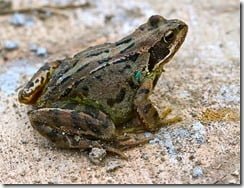 Of the three species of amphibian found in Ireland the common frog is by far the most familiar. Most people think of frogs as aquatic creatures, but in fact they spend most of their lives on land, only returning to the water in order to breed.
Of the three species of amphibian found in Ireland the common frog is by far the most familiar. Most people think of frogs as aquatic creatures, but in fact they spend most of their lives on land, only returning to the water in order to breed.
Adult frogs are from 6-10cm (2.4-4 inches) long. They are smooth skinned, tailless amphibians with powerful hind legs that are particularly well suited to jumping. The upper surface of the skin is variable in colour – ranging from a light yellowish brown to dark olive green. Some individuals even have a reddish tinge and almost black animals are not unheard of. Most animals exhibit a variable pattern of black or brown marks on the back and the species has a very distinctive brown patch behind each eye.
On the underside males tend to be a dirty white or pale yellow while females vary from pale yellow to orange. There are often brown speckles present in both sexes. Males tend to be slightly smaller than females and can be distinguished by the dark bluish-black nuptial pads – which are swellings on the first finger of their forelimbs. These swellings become much more pronounced during the breeding season and help the male to get a firm grip on the female’s smooth skin during mating.
Depending on the weather common frogs begin to emerge from hibernation in February or March and head straight for their freshwater breeding grounds. Males usually arrive before females and start croaking to attract a mate. Once females start to arrive the males start croaking in earnest and wrestle with each other to gain access to a potential mate. After overcoming his rivals a successful male will clamp himself to her back using his nuptial pads in a mating embrace known as “amplexus”. They may stay clamped together like this for days before spawning.
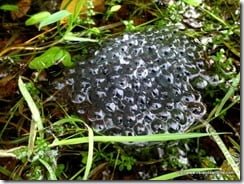 Eventually the female will lay 1000 to 4000 eggs which are fertilised by the male as they are released. This frog’s spawn floats in clumps protected by a jelly-like coating until the tadpoles emerge after 30-40 days. The tiny tadpoles feed on the remains of the frogspawn for the first two days before they switch to a diet of algae. As they grow bigger they also start to include aquatic insects in their diet. Hind legs develop at between six and nine weeks, the tadpoles lose their feathery gills and develop lungs – forcing them to the water’s surface to gulp air. Front legs are fully developed by about 11 weeks and the tail begins to be absorbed. At 12 weeks the metamorphosis is practically complete and the tiny froglet will leave the water, spending most of its time hiding in the vegetation on the water’s edge.
Eventually the female will lay 1000 to 4000 eggs which are fertilised by the male as they are released. This frog’s spawn floats in clumps protected by a jelly-like coating until the tadpoles emerge after 30-40 days. The tiny tadpoles feed on the remains of the frogspawn for the first two days before they switch to a diet of algae. As they grow bigger they also start to include aquatic insects in their diet. Hind legs develop at between six and nine weeks, the tadpoles lose their feathery gills and develop lungs – forcing them to the water’s surface to gulp air. Front legs are fully developed by about 11 weeks and the tail begins to be absorbed. At 12 weeks the metamorphosis is practically complete and the tiny froglet will leave the water, spending most of its time hiding in the vegetation on the water’s edge.
Frogs don’t feed during the breeding season, but once breeding is over they will eat practically any moving invertebrate that crosses their path, catching their prey with their long, sticky tongue. Adult frogs feed almost exclusively on land, but youngster frogs will also forage in the water. Although they are often seen by day frogs tend to be more active by night.
In winter frogs hibernate beneath compost heaps, under stones and logs or buried in the mud at the bottom of a pond where they survive by extracting oxygen from the water through their skin. They will not emerge until breeding time comes around again the following spring.
Photo Credit: ![]() All rights reserved by Foxglove Lane via the Ireland’s Wildlife Flickr Group
All rights reserved by Foxglove Lane via the Ireland’s Wildlife Flickr Group


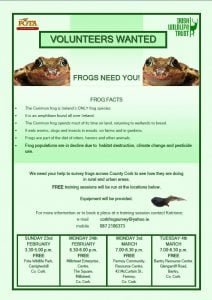
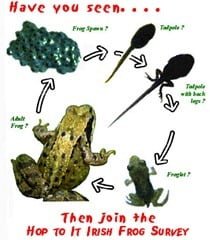
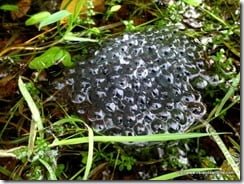




21 comments
Lee Van Schoor
I have two small ponds. One I dedicated to wildlife and the other has some goldfishes. I am squealing like a 3 year old to find some frog spawn but sadly its in the gold fish pond and I suspect the occupants will munch them. Is it ok to relocate the frogspawn the 4 meters to the wildlife pond? Any tips on how to do this? My second concern is that there’s a cold spell coming and I am worried that the temperature will drop. If that kills off this batch of frog spawn, do frogs respawn again once it warms up? Thanks for all the information.
Eli
I think they dont respawn later on. If I was you id move them whether its illegal or not there are no frog police going to call tó your door and you’re not taking them from the wild to out in your garden they’re already there so to me it makes sense. I think they need to not freezing when they are spawn the adults can handle freezing but not the little ones ..maybe you could try using garden fleece to cover the pond to keep frost off it. Or put a hot water bottle in the water over night when you think it will get below freezing. Poor things they used to be all over but I havent seen one for a long few years. The fleece might also keep birds from eating them too. I hope it works out.
Mari
I planted up my garden with grasses and shrubs during Covid. Today I was tracking down slugs and snails that damaged my plants and out popped a slim yellow frog. I threw a snail near him but he wasn’t interested and he disappeared. I’d like him to stay as earwigs snails and slugs are decimating my plants. However there’s quite a few cats around which is a concern. I don’t want to build a pond nor keep stagnant water. But think he probably needs drinking water. I’m totally amazed as I live in central Dublin. Will he stay in my garden or will he go further afield? Any tips re cats and water?
Ann O Hagan
Hello, Calvin,
I have some frogs who arrived into my polytunnel here in Co. Kildare. Is there a danger of the frogs carrying the Samonella infection while being in around my lettuce plants etc?
Loretta Mocanu
We have just moved into a new home and l was clearing an unused untidy part of the garden. As l was digging out a large clump of ornamental grass a lovely large green frog hopped out. I was so surprised , l dont want to disturb the frog and l stopped digging but l still want to remove a pile of branches and tidy up the area. What do you suggest.?There is an unused compost bin which l was going to start using but maybe l should leave it for the frog!
Thank you,
Kind regards,
Loretta.
Calvin Jones
Hi Loretta, Thanks for your comment.
If you move the frog to a quiet part of the garden with plenty of cover it will be quite happy and you can get on with your work in the garden. Frogs are great animals to have in the garden and will help keep the population of invertebrates often consconsidered to be garden pests under control.
Brendan McManus
Hi. Over the last few years our pond has been teaming with tadpoles. But this year although there was plenty of spawn it never floated to the surface and as a result I can only see a hand full of young tadpoles. There are however plenty of older larger tadpoles which I presumed are from last years crop as I have kept track of them over the winter months, but now I am wondering could they be Newt tadpoles? Are Newt tadpoles similar to frog tadpoles? The reason I think this is that I have seen what I think is a Newt in the pond.
Bernard
Hi, I live in East Clare and most days I walk through a bog and forest path. Yesterday I spotted some frog spawn along the path and also some in the grass near a pond. There is also a small running stream beside the path. Why would the frogs spawn on the path and in the grass?
Thanks
Bernard
paula o reilly
yes, saw 2 small frogs and 1 large , last week in my garden, dont know how they got there as no water around for spawening. .any clues?
Mrs Ruth Keys
Hi Calvin, have you came across an orange frog in Ireland in the more damp bog land areas? My husband has came across at least one large one while he was cleaning out the shough.
lee farrelly
Cant non native frogs survive in thewild and would the have a bad effect on our native frogs
Calvin Jones
It depends Lee… and yes, if they did survive they would probably have a detrimental impact on native amphibians.
Mark Doyle
Hi im putting in a garden pond i live in Westport
Will frogs find there way to my pond would love to get smooth newts to.
Someone said if ya were to put one in they would just leave the pond again as they only stay at spawning time
Calvin Jones
Hi Mark,
It’s true, frogs do only return to the water for spawning, and spend much of their time on land. However if your pond provides everything a frog needs then there is every chance that they will find their own way to your pond over time. Just be patient. A new wildlife pond takes time to mature, and it’s far better to allow wildlife to colonise naturally.
Translocating frogs and/or newts from the wild is illegal — and there’s always the danger you’ll introduce something nasty to your pond. If you create the right kind of habitat and allow it to mature naturally over a couple of years you’ll have a thriving wildlife pond that will give wildlife a home in your garden for many years to come.
Check out this PDF from Pond Conservation in the UK for a handy wildlife pond overview.
Mark
Hi Calvin
I have recently moved into a new house and over the past 3-4 weeks we have had the occasional frog appear in our kitchen. They are not getting in through open doors as they are hoping around the kitchen in the morning or after we return home from work (when all doors and windows are closed). Have you come across this before and have you any idea how they are getting into the house? Is it possible for them to get in through waste pipes (our sink pipe and outside drain pipe catching rainfall connect to the same disposal pipe). Thanks
Mark
pupils
Calvin, we have frogspawn in our school pond now and are watching eagerly it’s development. We enjoyed your video on the frogs eggs.
Scoil Náisiúnta R
ae na Scríne
Calvin Jones
Fantastic! I did spot some in there while out with the younger children during my last visit — we were out looking at likely nestbox sites, when we spotted the spawn in the pond. Keep an eye on it over the coming weeks — it goes through quite a transformation!
Calvin Jones
It depends Valerie — if you have frogs all summer, and it’s a deepish pond with a muddy bottom, then it’s likely they hibernated in the mud over winter and re-emerged very early (generally some time in Feb). It is also possible that they hibernated somewhere else and returned to your pond… or they could be a different batch of frogs entirely… hard to say for sure.
Valerie Hayden
There are 6 or more frogs in my fish pond, and have been making a lot of noise for the last week. I never go near them or the spawn. My pond fish are still in hibernation. Would they have stayed there from last year or do they keep returning annually to the same pond? I want to encourage them to breed if possible every year.
Fil Stewart
I noticed a breeding pair in the void beneath my cattle grid, but can’t remember quite when that was. However, I kept my eye on the location, and sure enough, there was spawn. I’ve “watered” the cattle grid to maintain water levels/quality. The tadpoles emerged, and appear to be thriving – no limb development to date. There is an escape route once they mature, and I’ve put some rocks in there for platforms once they require such…..